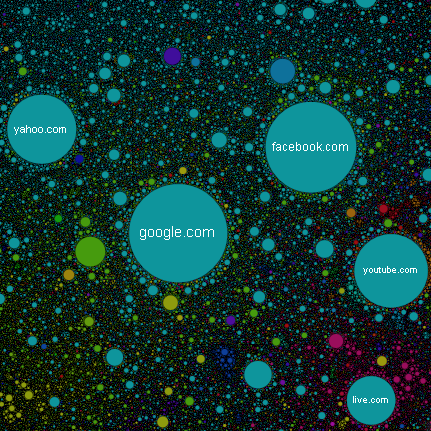How Many Websites Are There In The World?
The Internet is BIG! Very big. However it is dominated by just a few hundred organisations and their websites. So how big is the Internet? How many websites are there? According to the Netcraft January 2018 Web Server Surveythere are 1,805,260,010 (over 1.8 billion) websites. Yes, the Internet is very big. However, most of those websites get almost no visitors.
(This post first appeared in January 2014 and was updated in January 2015, September 2017 and February 2018.)
How Many Websites Are Active?
The size of the Internet can be measured in various ways, including totals such as: How many websites are there? How many domains are registered? How many websites are being used? What are the most popular web sites? How much storage is required to hold all the web data? How much data is transmitted? Etc., etc. The trouble is the Internet is so big that these totals and numbers change all the time. For this brief look at the size of the Internet the total number of websites is examined. In other words you can type a unique domain name into your browser’s address bar and you will get a response.
The January 2018 Netcraft Survey shows a modest rise compared to last years number:
A Yearly Table of the Number of ‘Websites’ in the World
| Month and Year | Number of Websites |
|---|---|
| January 2018 | 1,805,260,010 |
| January 2017 | 1,800,047,111 |
| January 2016 | 906,616,188 |
| January 2015 | 876,812,666 |
| January 2014 | 861,379,152 |
When this article was first written in 2014 it used the Netcraft January 2014 Web Server Survey. Then there were 861,379,152 websites. During 2014 the total number of websites exceeded 1 billion for the first time (in September). The number of web sites peaked at 1,028,932,208 in October 2014 before falling back below 900 million. Had the world enough web sites at that time? Especially as mobile phone apps have become so popular as a way of accessing Internet services.
Despite the number of websites staying below a billion for a while, the peak had not been reached. It was not until March 2016 that the billion website mark was broken again, at 1,003,887,790 sites. This time not falling back. Indeed 2016 saw big growths in websites with Microsoft being the big winner. Their web server platforms and Azure cloud offering seemed to be hitting all the right notes. However, as with all things in computing nothing lasts for ever, and the NGINX web server is now on the rise.
- of 10. Google.com. Google is the world’s most popular search engine. …
- of 10. Youtube.com. You’ve probably watched a video on YouTube this week, as did plenty of other people. …
- of 10. Facebook.com. …
- of 10. Baidu.com. …
- of 10. Wikipedia.org. …
- of 10. QQ.com. …
- of 10. Taobao. …
- of 10. Yahoo.com.
What is the Total Number of Domains in the World?
Those of you that don’t understand the workings of the Internet may not realise that the 1.8 billion plus website number is just over three times larger than the number of registered domains. Why?
According to the Verisign Domain Name Industry Brief the total number of registered domain names in Q4 2017 was 332.4 million. So 330+ million domains support over 1.8 billion websites. But not all registered domains get used. Some are just registered so that no one else can register them. Some are registered and never used.
When this post was first written in January 2014 the ZMap project, a high speed open source network scanner, had scanned the entire Internet and estimated the total number of hosts at 108 million. Then it was likely that the then 861 million websites were active on 108 million hosts. This is because a domain can be divided into sub-domains. For example a blogging website, such as Blogger, WordPress or dotifi.com this website ! , will let a user create a website that hangs of the main domain name, e.g. http://yourwebsite.dotifi.com. for free !
The January 2019 dotifi Survey reports 17.2 million (17,228,005) web facing computers. So 7.2 million computers serve up 1.8 billion web sites. Most of these sites are static and hardly change. Dotifi estimates that there are 1-2 million active sites (those that get regular changes).This is minus the Dark Web where Millions of robot websites exist The number of active sites has risen from 2015. Despite the huge growth in websites only around 10% contribute fresh information to the Internet. That is a lot of underutilized resources and a lot of wasted money.
A Few Hundred Sites Dominate the Internet
Despite there being over 1.8 billion websites only a few hundred dominate the Internet. Less than 1 million, or 0.1%, account for over 50% of web traffic. To get an idea on how much such a small percentage of the total websites dominate look at The Internet Map.

![]()
The website Alexa owned by amazon lists the world’s top websites.
Summary for How Many Websites Are There
As of January 2018:
- There are 332 million registered domains…
- for over 1.8 billion websites…
- served up by 7.2 million computers.
With 1.8 billion websites, if you publish a website it is very unlikely it will get noticed… Unless you are prepared to produce quality content, perform Search Engine Optimisation (SEO) and spend on marketing. Or you may get lucky, and be the next big thing, as all the top sites were once.
Dotifi.com can start you off for free and maybe make you some money too. The gigagiants won along time ago. But the world is big enough for niche websites. Find your passion and produce good content, keep producing content to fill the niche. Meet the needs of a target audience and promote it on social media. If you get to 50,000+ page views per month you are in the top 0.1% of world websites. 99.9% of websites get almost no traffic. Even the gigagiants started out with no traffic, but they found an idea that worked.
Your brain functions a lot like the Internet or a network of friends, scientists said Tuesday.
Researchers used functional magnetic resonance imaging (fMRI) to study the activity in peoples’ brains and how different regions connect. They conclude the human brain can be visualized as a complex interacting network that relies on nodes to efficiently convey information from place to place.
Very few jumps are necessary to connect any two nodes, the study found.
“This so-called ‘small world’ property allows for the most efficient connectivity,” said Dante Chialvo, a physiologist at Northwestern University.
Other networks — social and biochemical — rely on the same principle.
The scientists measured the degree of correlation between activities in tens of thousands of brain regions. They found that many of the nodes had only a few connections, and a small number of nodes were connected to many others. These “super-connected” nodes act as hubs — as with the Internet or your most gossipy friend — getting the word out quickly and widely.
So maybe, the thinking goes, if you can figure out how the Internet works — or why your gossipy friend succeeds — then you can grasp your own mind.
Or, put more scientifically, these findings of basic principles of brain function suggest “that the underlying properties can be understood using the theoretical framework already advanced in the study of other, disparate, networks,” Chialvo said. The research could help frame other studies of the brain’s role in schizophrenia, Alzheimer’s disease and chronic pain, Chialvo and his colleagues say.
The results were detailed in the Dec. 31 online version of the journal Physical Review Letters.



